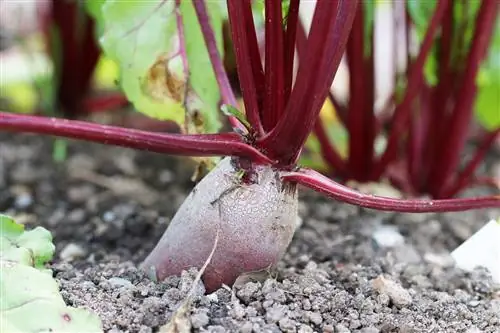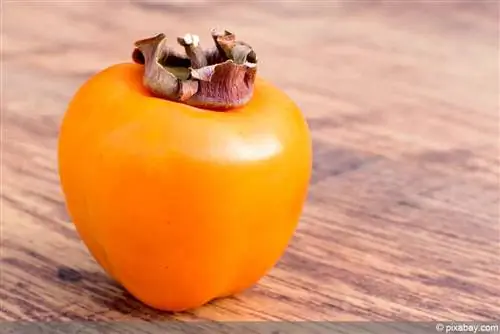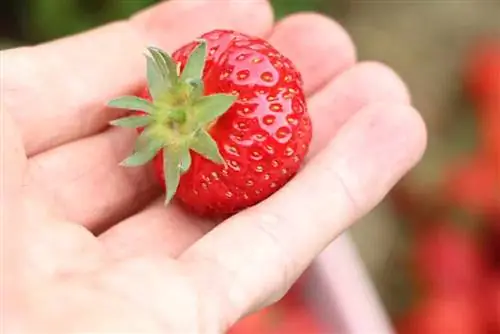- Author admin [email protected].
- Public 2023-12-17 03:39.
- Last modified 2025-01-24 12:45.
Beetroot is often grown in the garden because it does not have high demands on soil conditions and exposure to light. However, the soil in which the beetroot is grown should not be too rich in nitrogen, as this plant then accumulates too much nitrite, similar to chard or spinach. The beetroot should not be sown too early as they will sprout if they get frost during the growing phases. The shoots are not desirable for this plant. Therefore, sowing should not take place until April. If you want to be on the safe side here, wait for the Ice Saints. If frost occurs again, the beetroot can be protected with a thin fleece. Beetroot is ideal for storage. Therefore, the main cultivation should take place in June. The ripe fruits can be harvested and stored from October onwards. Storage takes place in boxes containing straw, sand or peat. This means the tubers are stored protected from light and cold. If the harvest takes place earlier, the fruits can also be boiled down and preserved.
Sowing the beetroot
Before sowing, the soil should be hoeed and compost added. The seeds are sown outdoors in April or May at a distance of around 10 centimeters within the individual rows. The rows should be approximately 25 centimeters apart. The sowing depth should be two to three centimeters. After sowing, another layer of compost, but not manure, should be applied. It is important to water the plants regularly after sowing. If the plant is to be pre-cultivated, it can be sown in manure bed boxes as early as March. The sprouts can then be planted in the garden in April. To support the growth of plants, rock dust can be hooked into the soil. Regular application of compost as well as hoeing and watering can also be beneficial for the growth of the plant.
The types of beetroot
Many people know beetroot as the well-known dark red root that divides opinion due to its earthy taste. However, there are different variations of varieties. In addition to the round variety, there are also those that have flat-round roots, as well as beetroots that have cylindrical roots or pointed roots. The white and yellow beets stand out, which taste mild and sweeter, not quite as earthy. One of the well-known varieties is the Formanova, which has a cylindrical shape. The Forono also has a cylindrical shape and is also very productive, which makes it very attractive for cultivation in the home garden. The Tonda di Chioggia is a ringed variety whose color is red and white. When eaten raw it is very sweet and tender. When this variety is cooked, the red and white stripes run into each other. The Egyptian flat round is an ancient variety that has deep red leaves, an aromatic taste and grows very quickly. Burpee's Golden is a beetroot that is orange on the outside and yellowish on the inside. These fruits taste very aromatic and sweet. The red ball is very commonly grown because it is an uncomplicated, round variety that is very aromatic. The Albina Veredura is a white beet that has a sweet taste and is often used to prepare raw vegetable salads. This variety can only be sown in June as it tends to bolt.
Pests and diseases
Beets are robust plants that are rarely affected by pests or diseases. A well-known pest of this plant is the beet fly. The beets can also be damaged by aphids or flea beetles. Furthermore, nematodes or beet analworms can wreak havoc on this plant. In addition, different types of beetles such as the tortoise beetle, the beet carrion beetle, the beet weevil or the tortoise beetle can cause damage to the fruit. In addition to the pests that can attack beetroot, there are also diseases such as heart and dry rot, root blight, yellowing disease and Cercospora leaf spots.
The harvest of fruits and the storage and preservation
As with many other plants, the plant's fruits last longest if they remain in the bed. However, the prerequisite is that there is no frost. The beetroot can withstand temperatures down to minus three degrees, but it should be harvested at lower temperatures. If the temperatures are higher, the plants can be harvested fresh shortly before consumption. If frost threatens, the plants should be carefully pulled out of the ground. In order to be able to store the fruits, they must not be injured. This is the only way that germs cannot penetrate and multiply there during storage. Before the fruits can be stored, the leaves must be removed. To do this, they are carefully twisted off. The roots can now be stored in the refrigerator for some time. If the tubers are to be stored for a long period of time, it is recommended to store them in the cellar. Boxes that contain moist sand are ideal for storing beetroot. The tubers must not be washed before storage. The remaining soil on the fruit protects it from infestation by mold and other germs or bacteria. If stored well, these will last until spring. In addition, the beetroot can also be fermented with lactic acid or boiled down.
What you need to know about beetroot
Beetroot needs a permeable, humus-rich, nutrient-rich soil. Care should be taken to ensure there is enough soil moisture. Since the small beets have relatively deep roots, the soil should be deep and not too acidic. Ph values between 6.5 and 7.8 are ideal. A fertilizer containing chloride is preferred as fertilizer. The best time for sowing is May and June. If you want to harvest early, you can start growing in pots in April and plant the young plants in the garden in May. In general, beetroot thrives best when sown directly outdoors. Their seeds are placed in grooves two to three centimeters deep and covered with soil. The beds must then be kept slightly moist. At a temperature between 15° and 20°C, the seeds germinate within two to three weeks.
If you want to harvest small beets, you can simply sow more densely. For larger beets, either ensure a higher distance when sowing (seed tapes) or space the young plants to a distance of around 15x5cm. The harvest time is around October-November, but you can also harvest the smaller beets continuously. Grows very well in places where legumes or kohlrabi were previously grown.
Best neighbors are borage, zucchini, onions, caraway, parsnips, lettuce. Also ideal for mixed cultivation with dill and savory. The taste also improves in mixed culture. Unfavorable neighbors, however, are leeks, tarragon, potatoes, chard, parsley, tomatoes, spinach, chives.
Caring for plants
In order for beautiful tubers to form, the beetroot needs sufficient water as it grows. If the tubers stick out of the ground, it makes sense to pile up some soil around the stem so that they are completely covered again. Furthermore, regular removal of weeds and hoeing of the beds ensures that the plants thrive.
Sowing and care at a glance
- Prefer in pots from April or sow outdoors from May
- Sowing depth: 2-3 centimeters
- Germination temperature 15-20°C, germination time 2-3 weeks
- make sure you water well
- Weeding and hoeing beds
- possibly pile up soil on the tubers
Harvest
These should not be grown as a pre-crop if you want to grow beetroot in this place afterwards. It is best to use trick 17 when harvesting. In the morning, lift the beets lightly with a fork without tearing off the roots and pull the beets out of the ground in the afternoon. This ensures that the nitrate content drops significantly. The fact that beetroot is so he althy is due to vitamins A, B1, B2, C, as well as folic acid, the antibiotic betaine, betalains, flavonoids, carbohydrates, phosphorus, potassium, magnesium, iron, calcium, sodium, copper, manganese, zinc. All of this is contained in the small beets. The red dye is very colorfast, so it is best to ensure that tablecloths and clothing do not come into contact with it. The red color is also difficult to remove from your hands.
Use & Storage
Beetroot naturally tastes best immediately after harvest. But they can also be stored quite easily in a so-called underground or basement rental. They are placed in light sand and stay fresh for months. In this way, in the past, when there were no refrigerators and freezers in most households, a supply was created for the winter. Many other types of vegetables are also suitable for this storage form, such as carrots or the many different types of cabbage.






